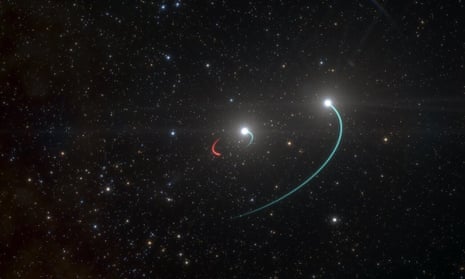Astronomers say they have discovered a black hole on our doorstep, just 1,000 light years from Earth.
It was found in a system called HR 6819, in the constellation Telescopium.
The system appears through a telescope as a single bright star, but telltale signs in the light emitted have previously revealed there to be two stars present.
Now experts say they have further analysed the data to discover there is another body within the system: a black hole with a mass over four times that of our sun, and the closest to Earth found so far.
“We realised that one could not describe what we saw with just two stars,” said Dietrich Baade, an emeritus astronomer at European Southern Observatory (ESO) and a co-author of the study.
“One of the stars is moving periodically, with a period of 40 days,” he said. “And the only way to understand that period and the very large [velocity] of 60km per second with a mass five times that of the sun was to infer that there is another very massive body which, however, is not visible.”
In other words, a black hole – an object typically formed from the gravitational collapse of a massive star.
The upshot, said Baade, is a so-called “hierarchical triple system”, which he explained by reference to a child’s mobile.
“On the one branch of the mobile you have two stars hanging, one of which is not visible, which is black – that is the black hole. And these two objects are orbiting each other,” he said. “And the other branch of the mobile you have one star which is much farther away from the other two.”
The black hole is unusual. “The hallmark of this black hole is that it is truly black,” he said. “Almost all the other black holes that we know are in the Milky Way – and there are only two dozen of them – shine very brightly in X-rays.”
Baade said the other black holes each had a companion star that feeds them with gas. However, this does not appear to be the case for the newly discovered black hole and its nearby star.
“This star is not so massive that it loses a lot of gas and therefore the black hole is starving and that makes it so dark.”
He said only a handful of similar black holes had been found previously, and they merited further scrutiny. “It may also be the first ever [black hole of this kind],” he said.
Baade added that HR 6819 – or rather, its stars – can be seen by the naked eye. “If you want to see it really overhead, you need to be at the southern tip of South America,” he said.
The new work, which is published in the journal Astronomy & Astrophysics, is based on data collected using telescopes at ESO’s La Silla Observatory in Chile.
“Theoretical models suggest that in the Milky Way there are between 100m and 1bn black holes,” said Baade. “We are finding a tip of an iceberg.”
The discovery could shed light on an unusual system in the constellation Gemini called LB-1. This system has previously been suggested to be composed of a star and a tremendously massive black hole – a finding that has foxed experts. Baade noted LB-1 appears to be very similar to HR 6819.
He said that suggests LB-1 could be a triple system, meaning its “dark object” would be a black hole of a more normal mass, or possibly a neutron star.
Dr Ziri Younsi, an expert on black holes at University College London, who was not involved with the research, said: “It’s remarkable that a black hole has been found so close to Earth,” noting for context that the centre of our galaxy is about 25,000 light years from Earth.
“This new study hints at the exciting prospect of a whole population of stellar-mass black holes lurking in our Galaxy,” Younsi said. “It also offers a potential new means to detect many more systems comprising such quiescent black holes in our galactic neighbourhood in the near future.”
